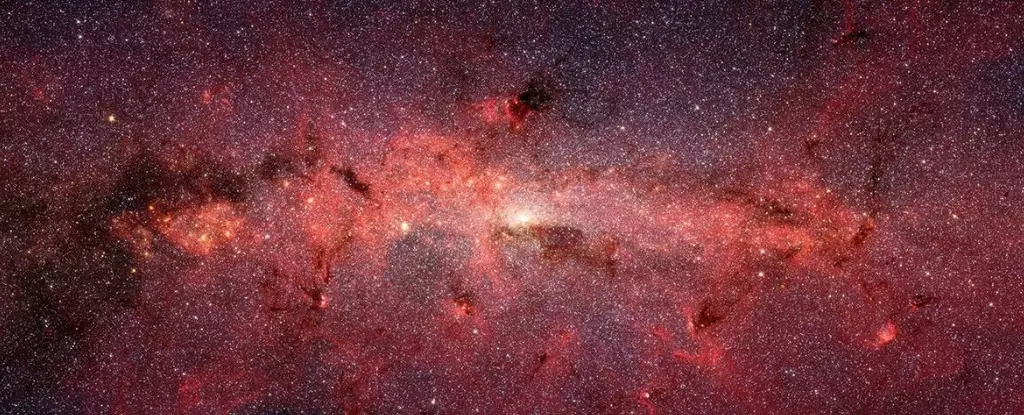In the vast expanse of the cosmos, few enigmas capture our imagination quite like the Milky Way’s central region—the Central Molecular Zone (CMZ). Spanning nearly 700 light-years, this dense area teems with molecular gas, and yet, its characteristics present a haunting mystery to astronomers and astrophysicists alike. Notably, the CMZ exhibits an unexpected degree of ionization, suggesting innumerable interactions at play. This peculiar phenomenon hints at the influence of unseen forces, leading us to ponder the very fabric of the universe we inhabit.
It is essential to recognize that the prevalent ionization within the CMZ challenges our understanding of cosmic environments. Ionization, the process that strips electrons from atoms, is typically driven by energetic particles. While it’s postulated that cosmic rays and starlight contribute to this phenomenon, neither source sufficiently accounts for the high ionization rates observed. This discrepancy invites an analysis that dovetails with another cosmic anomaly: the enigmatic gamma-ray emission observed at 511 kilo-electronvolts (keV).
Unraveling the Mystery of 511 keV Emission
The 511 keV gamma-ray signal, first detected in the 1970s, serves as a beacon of cosmic curiosity. This emission arises from the annihilation of electrons and their antimatter counterparts, positrons, resulting in flashes of high-energy radiation. Despite extensive scrutiny, the source of this gamma-ray glow remains elusive. Proposed explanations range from massive celestial phenomena—such as supernovas and black holes—to exotic processes involving neutron stars. Yet, no single model has convincingly resolved the intensity and distribution patterns observed in the emission. Herein lies an opportunity; an audacious hypothesis suggests these two enigmatic phenomena might stem from a unified source.
Just as we grapple with the unseen elements of our galaxy, dark matter looms as an ever-elusive presence. This gravitationally influential substance, constituting approximately 85% of the universe’s mass, remains shrouded in uncertainty. Attempts to identify the nature and properties of dark matter have veered toward one possibility that often flies under the radar: light dark matter particles, specifically those categorized as sub-GeV (giga electronvolts) candidates. Understanding these particles is vital for grasping the complexities of the cosmological tapestry.
Dark Matter: A Catalyst for Cosmic Interaction
Recent investigations into light dark matter have posited an intriguing scenario: these feathery particles could interact with their antiparticles, annihilating in the heart of the CMZ and yielding electrons and positrons as products. In the context of the dense gas surrounding this galactic core, these low-energy particles wouldn’t travel far, instead imparting energy locally and contributing to the observed ionization rates. The apparent connection between dark matter interactions and the intricate dance of ions opens an exciting chapter in cosmic research.
What is particularly striking is the notion that light dark matter could account for the ionization observed in the CMZ while simultaneously providing a plausible origin for the 511 keV gamma rays. The energy produced from the annihilation could fuel the gamma emissions as positrons interact with the surrounding environment, further intertwining these two enigmatic phenomena. However, while this hypothesis offers tantalizing possibilities, the specific parameters—such as interaction strengths and annihilation dynamics—remain entrenched in uncertainty.
The Path Forward: A Galactic Laboratory
As we tread further along this path of investigation, the CMZ may reveal itself as more than just a region of chaos; it could be a cosmic laboratory for testing our theories about dark matter. The uniformity of ionization across the CMZ suggests a smoothly distributed source, a conclusion more akin to the properties of a dark matter halo than any localized phenomena, such as isolated black holes or supernova remnants. This emerging perspective reshapes our understanding of dark matter’s role within the universe, elevating it from a mere abstract consideration to a tangible player in cosmic processes.
The potential breakthroughs in our comprehension of the CMZ’s mysteries hinge on advancements in observation technology. Upcoming telescopes promising improved resolution may facilitate deeper exploration of the spatial relationships between ionization rates and gamma-ray emissions. Yet the journey remains fraught with challenges, as definitive identification of these correlations could redefine our grasp of both the Milky Way’s center and dark matter’s overarching influence.
The universe has a knack for weaving complexity into the fabric of existence. As scientists peer into the intricate web of interactions that hallmark the CMZ, we are urged to contemplate the profound implications of our growing understanding. The pursuit of knowledge extends beyond mere curiosity into the realm of existential significance where, perhaps, the key to unlocking the universe’s secrets lies hidden within—and among the stars that populate our celestial neighborhood.


Leave a Reply